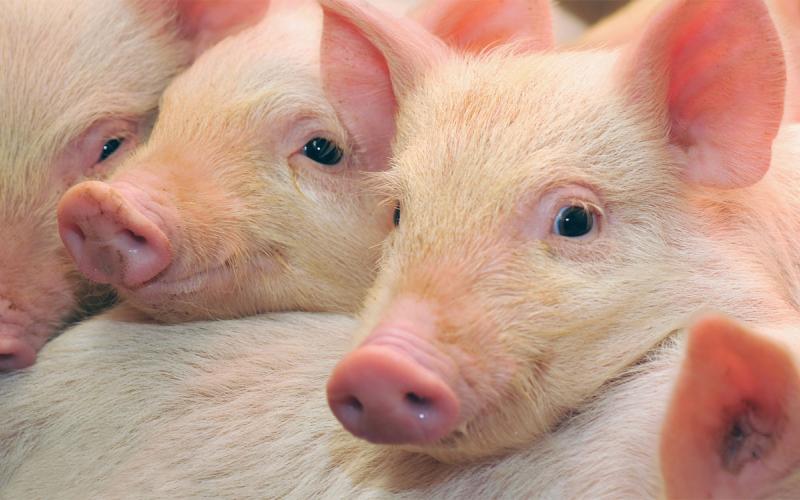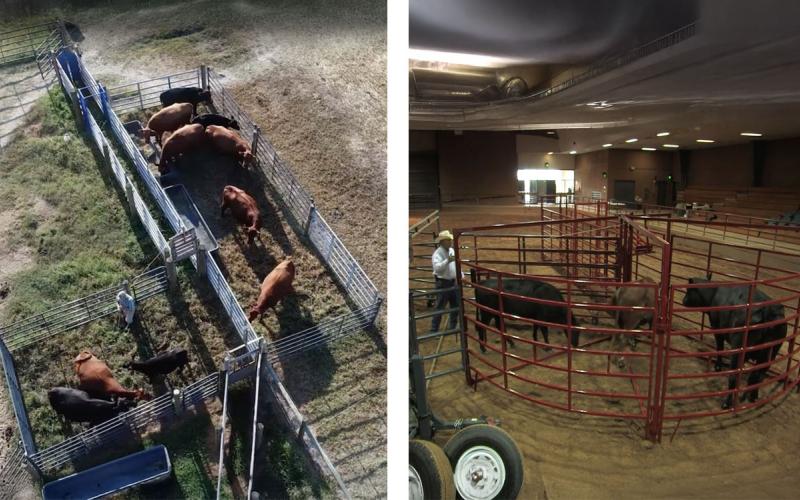
Written by Ryan Samuel, former SDSU Extension Swine Specialist.
Growing and finishing pigs require access to feed and water for growth. Two main types of feeders are found in swine barns, namely dry feeders and wet-dry feeders. The conventional dry feeders provide feed only, and water is accessed separately, whereas wet-dry feeders combine feed and water delivery. Feed is provided via a shelf below the feed hopper on the wet-dry feeder, and water is provided via nipples in the feed pan area. The actions of pigs at the feeder knocks feed down from the shelf, where it mixes with water before consumption.
Recently, every second pen in each of the two 20-pen rooms at South Dakota State University wean-to-finish facility were fitted with 304 stainless steel wet-dry feeders provided by SDI (Alexandria, South Dakota). The other half of the pens in the rooms remained with the original dry feeders from SDI. All of the wet-dry feeders were adjusted to the same shelf position. Both feeder designs were 60 inches wide and 40 inches tall with the feed pans divided into four slots. The pens were stocked with up to 15 pigs, which provided approximately 9 square-feet of floor space for each pig. Pigs had access to two cup waterers throughout the wean-to-finish period.
Pigs were weaned at 21 days of age from the Swine Education and Research Facility and placed into pens with an average starting weight of 12 pounds. Although the wet-dry feeders were in every second pen, as described above, the water nipples were not turned on during this period. Feeder type did not affect the growth performance of pigs during the first six weeks after weaning. On average, pigs gained 0.8 pounds per day and consumed 1.2 pounds of feed per day.
Following the nursery period, the water nipples in the wet-dry feeders were turned on. The water valves remained open for the duration of the grower and finisher pig stages. Starting at 80 pounds of body weight, pigs were weighed, and feed disappearance was measured every three weeks. Pigs in the wet-dry feeder pens were numerically heavier on weigh days compared to pigs in the dry feeder pens. The average feed disappearance in the wet-dry feeder pens indicated that those animals consumed 0.3 pounds more feed per day. Correspondingly, the average daily gain of pigs in the wet-dry feeder pens averaged 0.09 pounds per day greater, with no difference in feed efficiency compared to the pigs from the dry feeder pens.
At the conclusion of the finisher period, pigs were marketed through a commercial abattoir. The hot carcass weight (209 pounds vs. 202 pounds) and backfat thickness (18.8 vs. 17.5 mm) of pigs from the wet-dry feeder pens were greater, and the percent lean tended to be lower (55.6 vs. 56.7 %) than pigs from the dry feeder pens. However, the carcass loin depth was not different between the groups.
There were no differences observed in the growth performance of newly weaned pigs housed in pens with wet-dry feeders versus dry feeders in the wean-to-finish barn at South Dakota State University. As previous studies have observed, grower and finisher pigs fed from wet-dry feeders had improved average daily gain and average daily feed intake compared to pigs receiving feed from conventional dry feeders. The observations from the commercial abattoir indicated that heavier carcasses with more backfat, but similar percent lean, were marketed from pens offered feed through a wet-dry feeder compared to the dry feeder.
The differences in pig performance are important to consider in choosing feeder type between dry feeders and wet-dry feeders for the wean-to-finish barn. Wet-dry feeders have been observed to promote feed intake and body weight gain in growing and finishing pigs compared to dry feeders, but carcass lean can be reduced. Furthermore, wet-dry feeders can reduce water usage, which can translate to reduced costs for water and manure slurry removal. Regardless of feeder type, it is important to manage and adjust feeder pan coverage to provide adequate access to feed and to prevent feed wastage.


